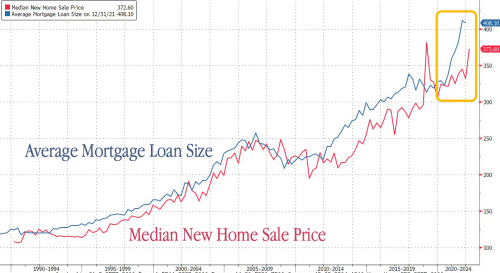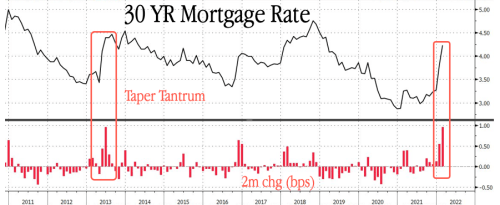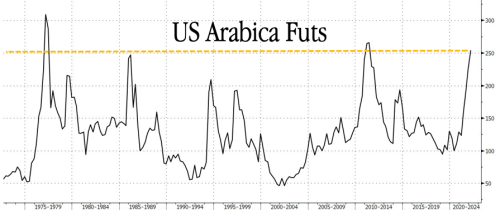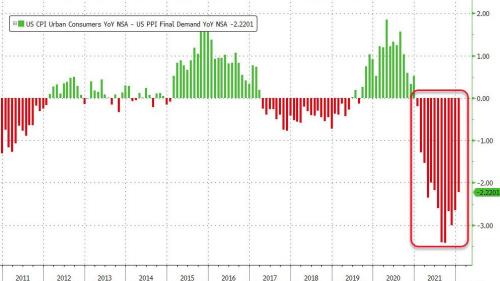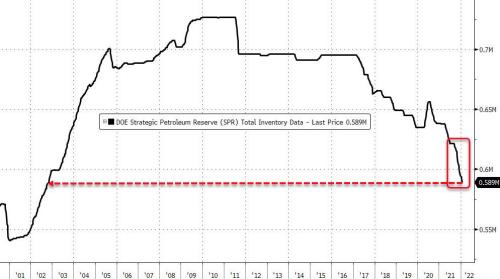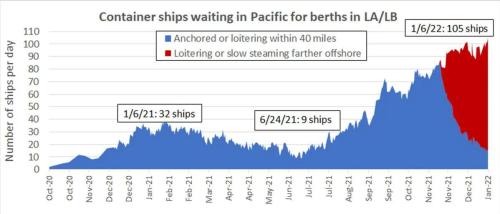For almost two years (starting in 2020 before you could see any consumer inflation at all), I have faithfully and consistently traced our trajectory toward scorching inflation that would cause a market disaster. Prior to that, inflationary burn-out was not an argument I ever made on this site (unlike some who perennially hyperventilate about hyperinflation).
Starting in 2020, however, I said inflation would be the news of our time.
I also recently laid out in a series of Patron Posts the massive economic collapse that we will see unfold now that inflation is forcing the Fed to tighten and cutting off the escape route the Fed has deployed whenever its tightening causes markets to crumble. That route, of course, would be a rapid return to quantitative easing, which rising inflation will no longer allow.
Well, that is, until now when the Fed may try to use wartime sanctions as an excuse to return to easing in a wartime stance, in spite of inflation. If they do, hyperinflation is the certain result, since we were already going to have continued high inflation. IF the Fed goes back to the easy answer of easing in our present high-inflation, high-shortage, low-production environment, we’ll move from the seventies-style inflation (complete with energy crisis) I predicted and traced out for the past two years to full Weimar-Republic inflation. I’m not saying the Fed WILL do that, but I could see it using the present sanctions as cover for such a move.
I have consistently predicted we’d enter a stagflationary recession at the start of this year, which would be prior to Putin’s War against Ukraine, and we are entering it, as the article below will show. I’m going to lay out the proof this inflation would have continued hot even without sanctions, using pre-war statistics, because we are about to see an even sharper rise in inflation due to the global sanctions imposed on Russia, and many will likely claim all the inflation in the months ahead is due to those sanctions, giving the Fed cover for its years of financial profligacy. In other words, “There is nothing the Fed could do about this; it is all because of the sanctions we had to impose to stop Imperial Putin.”
(I’m not arguing against the sanctions. I’m just saying they will make inflation worse, but they will also, therefore, easily become the convenient scapegoat for the collapse that was already assured by failure of the Fed’s repeated debt-based, money-printing recovery programs.)
Inflation was especially baked in by the Fed and the government over the past few years due to the COVID-lockdown shortages and the helicopter money and the momentous bailouts, and you can trust me on that because I laid out how all of it would proceed month by month, several steps ahead of the inflationary events over the past two years, and all of it, right to the end of the bull market in the Russell 2000 this year, has gone exactly as I anticipated before there was any thought around the world about Putin invading Ukraine.
The Atlanta Fed was already forecasting the economy this quarter would fall as close to recession as you can get without being in recession. Now, since the start of the war, it is forecasting this quarter will be recessionary. My only argument would be that it was generally right but overoptimistic:
 Federal Reserve Bank of Atlanta
Federal Reserve Bank of Atlanta
As I pointed out more than a month ago, using an earlier version of this graph, we were practically in recession back in January, and the war now has just tipped the balance as to which side of zero the Atlanta Fed believes we’ll end up on this quarter.
If the Fed is allowed to use the convenient excuse that this stagflationary recession is due to sanctions that it cannot do anything about, once gain, we will learn absolutely nothing as a nation about how destructive the Fed truly is to our economy with all of its central-planning manipulations. That’s my concern — that here we go with yet another “rince and repeat” Fed “restoration” cycle.
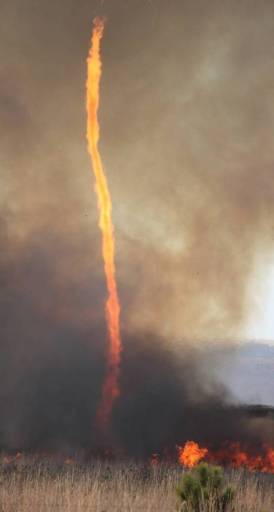 Fire tornado
Fire tornado
So, as the war and its sanctions intensify inflation and recession, let’s not take our eyes of the fact that both were already baked in. Unfortunately, there are not enough people who read here to have seen it coming. Most do not believe an inflationary recession (stagflation) was already wrapping its fiery arms of death around us. So, they’ll accept the new narrative as it develops if the Fed and its pocket politicians take that route, as seems probable to me.
To make it clear we were already here in an inflation vortex to hell, I’ll present the data I collected prior to the invasion to show the degree to which we were already caught in an inflationary vortex before I write my next Patron Post on how the war and all the global sanctions will likely bring profound shifts in the “world order,” altering and accelerating the path toward globalization and control. To lay all of that out, I’m going to present the many data points I already collected as evidence that the continuing rise in inflation was baked in before the invasion without much of my own commentary. In other words, just the facts:
The clear and present danger of continuing high inflation
As omicron restrictions faded, US Manufacturing surveys rebounded in February and today analysts expected the Services sector sentiment to also rebound, but the reality was different…. Markit’s survey finds that output charges are rising at the fastest pace on record…. ISM’s index of new orders also showed the slowest growth in a year, while a measure of business activity – which parallels the ISM’s gauge of factory production – fell to the lowest level since May 2020…. Prices are up in everything…
That’s the definition of “stagflation.” And here we see that drop was recessionary (any reading below “50”):
Additionally ISM’s gauge of services employment fell almost 4 points to 48.5, the weakest since August 2020, and one quote from the ISM Survey really caught our eye:… Severe labor shortages are expected well into 2022. Corporations need to increase wages and salaries to attract talent and get work done. Faster wage growth is expected to lead to increased inflation.
On February 17th, when Putin’s troops were still circling and Putin was lying by telling the world no invasion was on the horizon, Bill Blain wrote,
This Morning: Inflation should be front and centre for markets – give or take Ukraine, Oil, etc. How real is it, and just how bad could the consequences be? The news this morning is UK inflation hitting a 30-year high, home price rises in the US and UK earning more than the average working wage, and the Fed Minutes – yawn. Put these together and it looks torrid…. Expectations of aggressive moves in rates have doubled in recent weeks.
Aggressive moves to combat particularly aggressive inflation were already in play. In fact, the war has actually softened expectations of Fed tightening where inflation had been driving investors to price in the fastest Fed tightening in history as I pointed out in more than one article.
Rising stagflation risks … [seem] likely to me in the face of a consumer price shock, the Fed aggressively tightening rates, and … a looming credit-shock as banks kick away supports for sound but struggling companies. (I reckon we are about to see a corporate Armageddon unless banks ease their risk parameters.)
The mechanisms that drove cheap money since 2010 did nefarious damage within the financial asset system.
I.e., it was baked in … as follows:
Quantitative Easing buying back bonds to force interest rates lower caused the relative price of financial assets to shift. Negative interest rate policy forced investors to take more risk for less yield. The money pumped into the financial markets did not fertilize the real economy by boosting “real” lending – but was internalised within financial assets, pushing up the prices of bonds massively, and stocks by insane amounts. Inflation – pure and simple. The corporate bond market saw record volumes – but much of that remained in the financial asset market as debt was used to buy-back stock.
The result was 12 years of record inflation in financial assets while the real economy effectively deflated. Now – in a host of ways – financial asset inflation is crossing back over into the real economy. All it took was a catalyst: the Pandemic.
Now add to that the additional catalyst of war and the broadest and most intense sanctions ever tried. (But keep in mind those sanctions would have been doable and readily survivable if not for the incredible amount of dry rot we built into our debt-based, paper-money, economic structure that was already to go up in a great conflagration on its own.)
As Blain laid out, the economy was pumped up with massive money stored away in assets, and it took a pandemic, as I’ve said all along the way, to create the kinds of shortages that get people to release all that money to bid up prices. On top of that, of course, the pandemic redirected the money pumps to start shoving money into the pockets of the masses so they could spend as usual even when they weren’t working to produce or transport anything to spend it on because these laborers were all locked up by their governments!
My perception today is inflation is now thoroughly embedded in the economy – while supply chains may sort themselves, and energy scarcity may prove short-lived, a host of consequences, driving more consequences are now on the march. Inflation is driven not just by the prices of money, but by scarcity, wage demands, producer debt, and currency fluctuations. All of these are unstable and will see inflation rattle and roll markets for years rather than months.… Inflation is here, it’s here to stay and it’s here to really, really, really ***k us up.
“Years” of inflation were baked in, according to Blain, who wrote all of this before the war and any thought of sanctions.
Just the inflationary facts
You know where we have already seen that incendiary inflation the most:
At the same time when mortgages hit record size, mortgage rates went on a tear as well:
Worse than the “Taper Tantrum.” That’s a double whammy on your most expensive budget item if you bought a home in the past year, and it’s slowly working it’s way down the rent stream as well.
In case you think you’re going to steady your nerves about that with a soothing cup of coffee, Goldman’s head commodity strategist and one of the closest-followed analysts on Wall Street, as ZH described him, said he’s never seen commodity markets pricing in the shortages they are right now:
“I’ve been doing this 30 years and I’ve never seen markets like this,” Currie told Bloomberg in an interview. “This is a molecule crisis. We’re out of everything, I don’t care if it’s oil, gas, coal, copper, aluminum, you name it we’re out of it.”
This leaves us with one particular commodity that most Americans use daily, and it’s not crude products, such as gas and diesel, but, in fact, coffee. Over 150 million daily drinkers might be subjected to prices that may ‘soar out of control,’ according to a new report from analysts at Rabobank….
Inventory could plunge to “half a million bags in three months,” and the “fast pace of decertification could lead to uncontrolled prices spikes in the short-term.
We were “out of everything,” according to the commodities expert who had never seen any thing like this, before any thought of war or sanctions. Coffee futures are, as a result (pre-war), back in the all-time high zones:
And so it goes with producer price inflation in those background figures that drove me to show for months that an inflation conflagration was about to show up in consumer prices:
These input prices for consumer-facing companies have now bounced back to the top of the range of the red-hot producer-price inflation that began a year ago.
Measuring that as the accumulation of price increases in index value and not as monthly percent changes, that looks like this:
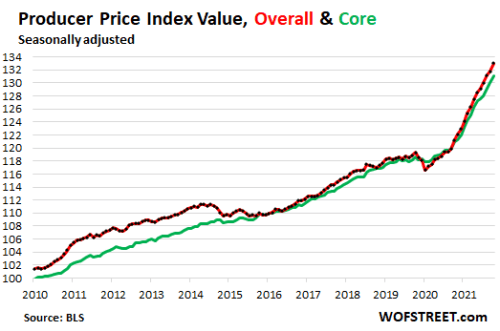
Things have been a little steep on the producer side since I started predicting high consumer inflation back when we first emerged from that crash in 2020, saying all along the way this massive problem of too much money chasing too few goods would become hot enough to speed up Fed tightening and kill the stock market. As you can see, there was NO interruption in that flight path all the way through the end of 2021 where the data stop.
Moreover …
Producer price inflation has now seriously spread into services, with the PPI services jumping by 0.7% in January from December.
The [overall] producer price index, which measures final demand goods and services, increased 1% for the month, against the Dow Jones estimate for 0.5%. Over the past 12 months the gauge rose an unadjusted 9.7%, close to a record in data going back to 2010.
All before war and sanctions.
Does anyone see a gap in the graph below between the cost of goods for intermediate demand (the products that go into other products) and the cost of goods for final demand (retail) to where consumer prices might have some catching up to do?
That pipeline flows down hill to the consumer … [and] is negative for the 13th straight month, as for now, input costs are not all flowing through to output costs for consumers.
Do you think they won’t?
Here is the cumulative difference between what percentage of price increases has been handed down from producers to the consumer and what has not — the area in red representing the difference in percentage price increases between producers and consumers each month that have not been passed along … yet:
Good luck with companies just indefinitely sitting on all of that! Because, yeah, that’s what companies do.
Not.
“PPI offers a window to the price pressures that businesses are facing, and which will likely be passed on to consumers in the way of consumer price inflation in the months to come,” PNC economist Kurt Rankin wrote. “Strong gains across the board for businesses reinforce the inflationary concerns that the Federal Reserve is set to battle this year with monetary policy, and which the economy in general has recently begun expressing caution and concern over.”
And that was published just before the war and all of its related sanctions. It is what was already baked in. That is why investors were betting on more and more Fed rate hikes in 2022 to fight all of what they saw coming and why bonds were pricing upward before the sanctions over Putin’s War.
Yet, the increases that have already priced through to consumers (that are not part of the red zone in the graph above) are, frankly, already astounding:
The consumer price index for used cars and trucks jumped up by 40.5% from January 2021 to January 2022.
And you can’t outrun that inflation in car prices because…
Between January 2021 and January 2022–President Joe Biden’s first year in office–the price of unleaded gasoline increased 40.8 percent, according to the Bureau of Labor Statistics.
… because you’ll be out of gas.
Gas Prices At Pump Highest Since 2013
The average price of gasoline surged to the highest level in seven years, according to new AAA fuel data.
That, too, was pre-war. Of course, the wartime sanctions will make that worse and already are making it worse if you’ve stopped by a fuel pump lately, but it was building even before the war. Meanwhile, our national Strategic Petroleum Reserve is already at its lowest in twenty years, so don’t expect any reprieve:
All blocked up and nowhere to go
Port blockages are a big factor in the shortages that are part of the inflation recipe, so to understand where inflation was headed prior to Putin’s War, one needs to know whether these port backups were starting to clear out or not.
A month prior to the war, the Wall Street Journal reported the situation as follows:
Port congestion is spreading across the country, threatening to extend shipping delays and drive up costs for importers seeking to get around the bottlenecks at Southern California’s big gateway complex…. Container ships are backing up off coastlines from Oakland, Calif., to Charleston, S.C….
“It’s supremely frustrating to be an importer right now,” said Nathan Strang, director of ocean trade lane management at Flexport Inc., a San Francisco-based freight forwarder. “Everybody wants to find a relief valve and all of the relief valves have been plugged….”
The number of containers waiting more than 15 days for pickup at Charleston, the country’s eighth-largest gateway for container imports, exceeded 7,000 boxes last week, an increase of 40% compared with one month earlier….
[And in LA and Long Beach,] the queue of ships waiting to enter the port has remained at about 100 vessels for almost two months despite port and Biden administration attempts to clear the backlog.
So, in short, “No.”
Here is what shipping constipation looked like at the start of the year:
And to put that picture in perspective as to what it means:
Clearly NO headway has been made since the backlog began to develop one-and-a-half years ago! The only thing that changed is that ships started waiting out at sea for their turn at port, rather than at anchorage around congested ports. That’s not a reduction in backups. It’s a traffic revision due to congestion. And that is where things were just before the war and its sanctions. So, do not accept the likely coming lie that all inflation from this point forward is due to the war and its sanctions. There was NO reprieve anywhere on the horizon!
Underfed because overFed
One of the places we feel inflation the most is in our grocery budget. We have to feed the car with fuel and feed ourselves as high priorities, and both costs were rising right up to the war (but, of course, will rise a lot faster now due to the sanctions on Russian grains and the war tearing up the fields in Ukraine (Europe’s breadbasket) making a massive drop in crop sales there a certainty, pushing up corn prices and, therefore, ethanol prices, in addition to petroleum prices.
Now, US and Canadian citizens might feel they’re safe from all of that, but they’ll need to rethink that. When Europeans find their food sources greatly cut back, they go to faraway markets, including the US and Canada to buy the food they need. That increase in demand in those markets drives up prices in those markets, as does (even worse) all the speculation that is built into our commodities casino. As with stocks, investors believing corn prices will go higher, bid up futures on corn prices up, and that hits you right in the ol’ breadbasket because all the producers of products using corn or corn syrup have to pay those prices that have been bid up by speculators, so all the speculation passes down the food chain.
(That is one reason I believe we need to redesign the laws that govern commodity markets to strip out the dominant casino-like aspects that make all consumers pay more for everything just so the rich can have another casino to play in where they can get richer still without actually producing anything or providing any service — the kind of argument I make in the final chapter of my book Downtime: Why We Fail to Recover from Rinse and Repeat Recession Cycles.)
The world, as a whole, had already closed 2021 at a cost level for food matching the highest indexed food prices over the course of, at least, three decades:
Food prices remain at a decade high and have risen sharply since the beginning of the pandemic, driven by snarled supply chains, harvest setbacks, soaring farm costs, and high demand. Last month, increases in grains, dairy, and sugar were the primary driver in FAO’s food price index. Laggards were meat and vegetable oil.
You can see the rise in food prices is a global phenomenon that was building continually throughout 2021:
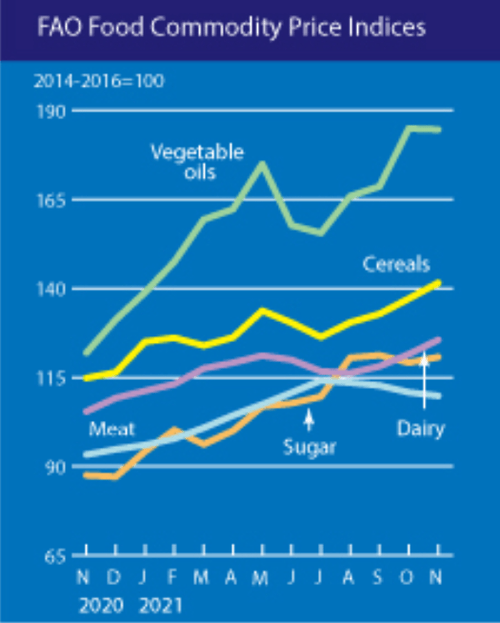
And you’ve undoubtedly already felt food inflation building rapidly in your own local grocery stores prior to the war, but here are just a few items that are endemic of what is happening and was already about to happen to an even greater extent across the board before there were any stirrings of war in Ukraine:
The dominant features of the basic U.S. dairy situation continue to be tighter milk production, record export volumes, higher prices, sluggish domestic consumption, and dropping inventories…. December prices for nonfat dry milk and dry whey were the highest monthly prices since 2014; they, as well as December butter and cheese prices, were all among the highest observed during all months since the beginning of the year 2000.
Of course, rising fertilizer prices due to the cut-off of Russian oil and gas will make that worse, as will rising corn prices for the reasons mentioned earlier. It will cost a lot more to feed cows:
The crux of the problem is the pandemic-related issues, such as dairy cows becoming too expensive to feed, so farmers reduced their herds by sending animals to slaughterhouses. The remaining cows are being fed less, which means lower milk output. Compound that with rising labor and energy costs, margin compression is hitting farmers where it hurts: the pocketbook…. Milkflation is expected to persist “well into 2022,” the industry group said…. Other breakfast-designated commodities, such as oranges, lean hogs, wheat, and coffee, have risen over the last year due to supply-chain disruptions
Again, that milk was spilled before the war and its sanctions. Even your basic hotdog was set for soaring prices prior to Putin’s War:
The makers of top food and consumer goods brands plan to raise prices in the spring…. Kraft Heinz (KHC) said in a recent letter to its customers that it will raise prices in March on dozens of products, including Oscar Mayer cold cuts, hot dogs, sausages, bacon, Velveeta cheese, Maxwell House coffee, TGIF frozen chicken wings, Kool-Aid and Capri Sun drinks.
All of that was already scheduled by Warren Buffett to rise this month. And not just a little either! A LOT:
The increases range from 6.6% on 12oz Velveeta Fresh Packs to 30% on a three-pack of Oscar Mayer turkey bacon. Most cold cuts and beef hot dogs will go up around 10% and coffee around 5%. Some Kool-Aid and Capri Sun drink packs will increase by about 20%.…
Kraft Heinz is the latest consumer manufacturer to announce plans to boost prices early in the year. Last week, Procter & Gamble (PG) said that it was raising prices for its retail customers by an average of about 8% in February….
Conagra, which makes such brands as Slim Jim, Marie Callender’s and Birds Eye, recently said it will raise prices later this year as well.
All of that was already baked in because that’s what happens when all those producer price increases that had not been passed along yet, which I mentioned above, finally get priced in quickly because producers had cut their profit margins back as long as they could to avoid losing market share, but are now finally giving up on holding back the tide. So long as they believed the Fed’s assurance that these problems were transitory, they could hold back on passing along their own cost increases in order to maintain market share; but it was never about to be transitory as the Fed had been telling everyone:
Cargill CEO David MacLennan recently changed his mind about “transitory” inflation and now believes it will be more persistent with higher food prices in 2022. He blamed elevated food prices on snarled supply chains, labor shortages, and adverse weather conditions, among other things.
So, don’t think when you see prices leap up at the supermarket this month, that it is all because of the sanctions just imposed around the war Putin just created just because of the timing. These prices were already scheduled to blow through the roof in March before anyone had a ghost of an idea that such a war was coming, and retailers are likely to use this timing to pass through even more of the inflation they have been holding back as they now have cover, too.
My concern, as I say, is that the Fed will seize the opportunity to tell everyone that none of this is their fault, extending from years of money printing, so there is nothing they could have done about it or can do about it; and the government will tell you that none of this is the government’s fault either, extending from all their COVID lockdowns and their helicopter money to the masses. The Fed and all of its financial media parrots and dodo birds may even use this argument as an excuse to let things run hotter by going back to easing to avoid crashing the markets they are married to, so long as Fed can use this crisis to keep the blame for inflation off its back.
Just remember that correlation is not always causation, and this is one of those times. Huge price increases, as shown above, were already baked in prior to the sanctions of war and were already set to start showing up at the grocery store in a big way “in March” and “later this year.” The sanctions, of course, will make that inflation worse, and the average person and business will find blaming the sanctions conveniently easier to understand and explain than blaming all that has already been done by the Fed in years past. After all, most economists and stock brokers don’t believe any recession was coming at all, and have been parroting each other already in saying we were in the greatest economic boom ever. If that’s how it goes then , once again, the Fed gets away with the troubles it created, and we get to attempt to do it all again.
However, QE or low interest won’t work this time around because they will fan the fires of inflation already hugely at play and quickly spin them up into a hyperinflationary inferno if tried. I’m not saying the Fed will go that route, but it has a habit of doing so! Printing your way out of an economic collapse has always been a tempting easy solution.
 Loyalton. California, wildfire tornado
Loyalton. California, wildfire tornado
Liked it? Take a second to support David Haggith on Patreon!



